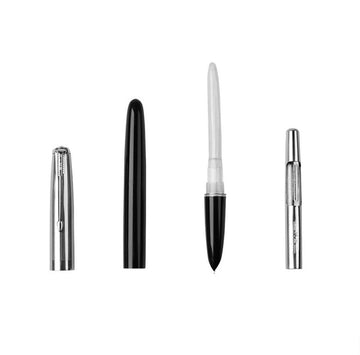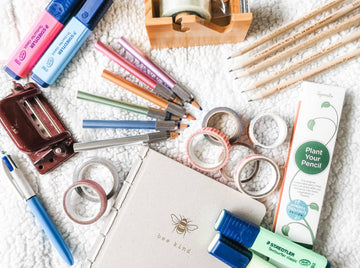Fyllepennevolutionen under ett sekel: Klassiska designer, innovativa genombrott och varumärkesarv
Introduktion
Fyllepennan är mer än bara ett skrivinstrument – det är en kulturell ikon som har format mänsklig kommunikation, konstnärskap och hantverk i över ett sekel. Från dess tidiga dagar som en lyxvara till dess moderna status som en blandning av tradition och innovation, speglar fyllepenne resan bredare trender inom design, teknik och varumärkesbyggande.
Denna artikel utforskar de viktiga faserna i fyllepennevolutionen, från banbrytande uppfinningar till legendariska märken, inklusive de ofta förbisedda bidragen från kinesiska tillverkare som Hero och Wing Sung.
1. Ursprung och tidig utveckling (1800-talet – tidigt 1900-tal)
Från fjädrar till metallspetsar
Innan fyllepennan förlitade sig skrivare på doppennor och fjädrar, som krävde ständig bläckdopning. Det första stora genombrottet kom med Lewis Watermans kapillärmatningssystem (1884), som förhindrade läckage och gjorde fyllepennor praktiska för vardagsbruk.
Framväxten av ikoniska märken
- Parker (1888) – Introducerade "Lucky Curve"-bläcksystemet (1894), vilket minskade läckage.
- Sheaffer (1907) – Patenterade hävelfyllningsmekanismen, vilket förbättrade bläckkapaciteten.
- Montblanc (1906) – Etablerade sig som ett lyxmärke med Meisterstück (1924).
Fyllepennor anländer till Kina
I början av 1900-talet importerades fyllepennor till Kina som lyxvaror. Lokal produktion började på 1930-talet, med märken som Hero och Wing Sung som framträdande inhemska alternativ till västerländska pennor.
2. Den gyllene eran: Mästerverksdesigner (1920-talet–1950-talet)
Västerländska innovationer
- Parker Duofold (1921) – Djärva färger och hållbar design.
- Sheaffer Balance (1929) – Strömlinjeformad form och inbäddad spets.
- Parker "51" (1939) – Inbyggd spets och snabbtorkande bläck, en av de mest sålda pennorna någonsin.
Kinas tidiga bläckpennindustri
- Hero (英雄) – Startade som Huafu Pen Factory (1931), och producerade senare den berömda Hero 100 (1962), en förfinad version av Parker 51.
- Wing Sung (永生) – Känd för prisvärda, pålitliga pennor som Wing Sung 612, mycket använda i skolor och kontor.
Kulspetspennans utmaning och branschskiften (1960-talet–1980-talet)
Kulspetspennans revolution
Framväxten av billiga, engångskulspetspennor på 1960-talet hotade försäljningen av bläckpennor globalt. Många västerländska märken skiftade fokus till lyx- och samlarpennor.
Kinas unika väg
Under en planekonomi fortsatte kinesiska märken som **Hero och Wing Sung** massproduktion och levererade pennor för studenter och statlig användning.
- Hero 100 förblev en statusymbol i Kina.
- Exportinsatser – Vissa kinesiska pennor såldes utomlands som budgetalternativ.
4. Den moderna eran: återupplivning och innovation (1990-talet–nutid)
Västerländska märken blir lyx
- Montblanc – Utökade med exklusiva limiterade upplagor (t.ex. Writers Series).
- Parker & Waterman – Fokuserade på exklusiva företagsgåvor.
- LAMY – Blev populärt med minimalistiska designer som **LAMY 2000 (1966)** och Safari (1980).
Kinas bläckpennans renässans
- Heros kamp och comeback – Efter nedgång på 1990-talet återupplivade Hero senare klassiker som Hero 100-återutgåvan.
- Nya märken dyker upp** – Företag som **Kaco och Picasso** introducerade moderna, stilfulla pennor.
- Nisch- & specialpennor – Märken som **Moonman (Majohn) och PenBBS** fick globala fans för innovativa påfyllningssystem.
5. Legendariska märken och deras historier
Västerländska ikoner
- Parker** – Från "51" till Sonnet, en symbol för amerikansk innovation.
- Montblanc** – Det ultimata lyxmärket för pennor.
- LAMY** – Tysk ingenjörskonst möter Bauhaus-design.
Kinesiska legender
- Hero (英雄) – Kinas "folkets penna".
- Wing Sung (永生) – Prisvärd men hållbar, älskad av studenter.
- Nya utmanare – Moonman, PenBBS och HongDian lockar globala samlare.
Slutsats: Fylldpennans framtid
Digital ålder vs. analog tradition
Medan tangentbord dominerar det dagliga skrivandet, frodas fylldpennor som symboler för hantverk, personlig uttrycksförmåga och lyx.
Kinas växande inflytande
Kan kinesiska märken som Hero och Moonman konkurrera med Montblanc och Pelikan på premium-marknaden?
Vad händer härnäst?
- Smarta pennor? – Kan digital bläckspårning integreras?
- Hållbara material – Miljövänliga hartser och återvunna metaller.
- Anpassningsboom – Fler märken kan erbjuda specialanpassade spetsar och gravyrer.
Appendix: Snabba tips för pennentusiaster
✔ Underhåll – Skölj regelbundet med vatten för att förhindra igensättningar.
✔ Klassiska modeller att prova – Parker 51, LAMY 2000, Hero 100.
✔ Samlande – Vintage kinesiska pennor (Hero, Wing Sung) är undervärderade pärlor.
Slutliga tankar
Fylldpennans resa – från ett praktiskt verktyg till ett kulturellt föremål – visar att även i en digital värld **är konsten att skriva för hand fortfarande viktig**. Oavsett om du är samlare, författare eller bara uppskattar fint hantverk, finns det en fylldpenna med en historia som väntar på dig.
Vilken är din favoritfylldpenna? Dela med dig i kommentarerna! 🖋️





